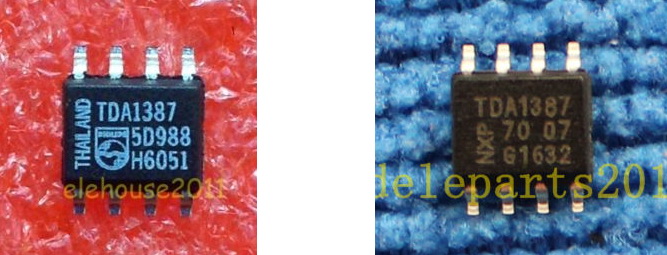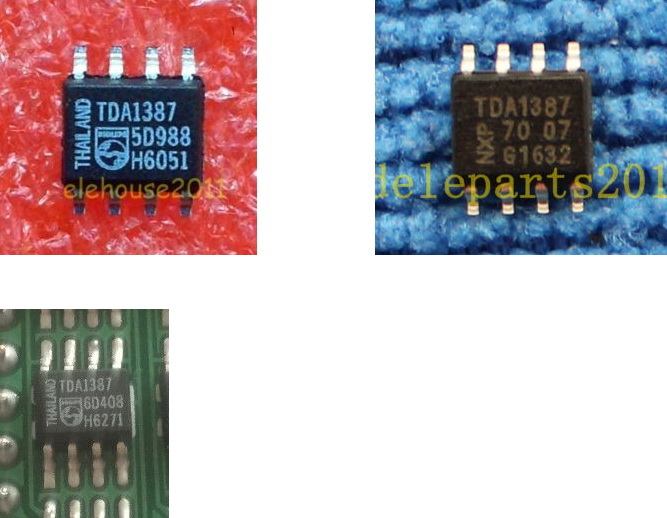Hi
2 months ago, when asking about DACs, abraxalito recommended me to try a TDA1387 based DAC.
It is an old, multibit DAC chip,
and the product that is based on it today, is built using recycled TDA1387 chips.
I bought a ready made DAC product based on this chip,
and from 8 different DACs that I listened to, this was the best one.
It's the one I am currently using.
Here is the product:
L1387 HIFI USB DAC 4X Quad TDA1387 USB decoder beyond the TDA1543 | eBay
From what I saw in eBay, you can also buy there the chip itself, should you want to implement the DAC product yourself, from scratch.
The thing is, that when searching for the chip, 2 types of results come up.
On the first the mfrr is printed as Philips,
and on the second it's NXP:

According to Wikipedia, Philips morphed into NXP, in 2006..
So my question:
Is there a difference in the sound, between the Philips labelled chips and the NXP labelled ones?
BTW,
From this labelling, we can also deduce that the NXP labelled ones were manufactured in or after 2006,
which is surprising - I thought all manufacturing of the TDA1387 has ended in the end of the 1990s..
In any case, hopefully someone here can recommend which ones to choose..
Thank you
2 months ago, when asking about DACs, abraxalito recommended me to try a TDA1387 based DAC.
It is an old, multibit DAC chip,
and the product that is based on it today, is built using recycled TDA1387 chips.
I bought a ready made DAC product based on this chip,
and from 8 different DACs that I listened to, this was the best one.
It's the one I am currently using.
Here is the product:
L1387 HIFI USB DAC 4X Quad TDA1387 USB decoder beyond the TDA1543 | eBay
From what I saw in eBay, you can also buy there the chip itself, should you want to implement the DAC product yourself, from scratch.
The thing is, that when searching for the chip, 2 types of results come up.
On the first the mfrr is printed as Philips,
and on the second it's NXP:

According to Wikipedia, Philips morphed into NXP, in 2006..
So my question:
Is there a difference in the sound, between the Philips labelled chips and the NXP labelled ones?
BTW,
From this labelling, we can also deduce that the NXP labelled ones were manufactured in or after 2006,
which is surprising - I thought all manufacturing of the TDA1387 has ended in the end of the 1990s..
In any case, hopefully someone here can recommend which ones to choose..
Thank you
Last edited:
Yes, Phillips morphed into NXP, as you say. The likelihood is that the chips are identical, except for the maker's name, but I suppose we should consider the possibility that the device has changed since the change of name. It seems unlikely, though. Changes cost money, so why change if there's no reason to?
Just my two pennyworth.
Just my two pennyworth.
Thank you both for the answers.

BTW,
always when you see implementation using multiple chips of the TDA1387,
you see 4x, 8x, 16x..
Is there a reason why they use power of 2?
Can't one use 5x for example?
I ask this, because If I buy 10, then I can use 5x for each channel.. thus using all 10
I am glad I'm bringing something newI have never seen an NXP marked TDA1387 before, your picture is the first one for me.
All my TDA1387s have looked like the first image with the Philips wavy-line logo on.
BTW,
always when you see implementation using multiple chips of the TDA1387,
you see 4x, 8x, 16x..
Is there a reason why they use power of 2?
Can't one use 5x for example?
I ask this, because If I buy 10, then I can use 5x for each channel.. thus using all 10
Last edited:
here you have another nxp https://www.diyaudio.com/forums/digital-line-level/313395-tda1387-dac-pcb-front-35.html#post5613320
I thought there might be a functional reason why it is like this,No reason that a X5 DAC shouldn't be built
for example the bits are split between the 4 chips, and so it must be a power of 2..
But OK..
Thanks
BTW,
since the TDA1387 was so nice, and since I am curious I want to try more old multibit DACs.
(hopefully a fully made board, and not to build from scratch)
Can you recommend other old multibit DAC chips that have a really good sound,
and that are available for purchase today (for example a ready-made board from ebay/ali)?
The fact that Lee made about 5 models from the TDA1387, yet only 1 model from the TDA1543, makes me thing that the resulting sound was not that good, to invest more in it and develop more models out of it..Have a try with TDA1543. Can't think of any more cheap multibit DAC chips.
So there are simply no more old multibit DAC chips available today for purchase?The next step up would be PCM1702 (a 20bit DAC) but that's becoming more and more expensive and is already well more than 100X the price of the TDA1387.
That's sad..
Last edited:
There are plenty, just none within two orders of magnitude of TDA1387's price.
Non-audio DAC chips are worth a look, for example this one : ???? AD768AR AD768 ???-???
Non-audio DAC chips are worth a look, for example this one : ???? AD768AR AD768 ???-???
Non-Audio would give a better result than newer audio ones?
Interesting.
There are 2 products (with enclosure even, and all), that are based on PCM1793 and PCM1794:
SMSL SD-793II (PCM1793) - 65$:
SMSL SD-793II DIR9001+PCM1793 Coaxial/Optical DAC+Headphone Amp 96KHZ 24Bit B | eBay
FX-Audio SQ5 (PCM1794) - 81$:
Amazon.com: FX Audio SQ5 Optical/Coaxial PCM1794 Digital Hifi Audio Decoder DAC (Silver): Electronics
Are the PCM1793/PCM1794 worth anything?
How old are them, and are they multibit?
(the product page on TI does not mention it)
Interesting.
There are 2 products (with enclosure even, and all), that are based on PCM1793 and PCM1794:
SMSL SD-793II (PCM1793) - 65$:
SMSL SD-793II DIR9001+PCM1793 Coaxial/Optical DAC+Headphone Amp 96KHZ 24Bit B | eBay
FX-Audio SQ5 (PCM1794) - 81$:
Amazon.com: FX Audio SQ5 Optical/Coaxial PCM1794 Digital Hifi Audio Decoder DAC (Silver): Electronics
Are the PCM1793/PCM1794 worth anything?
How old are them, and are they multibit?
(the product page on TI does not mention it)
I'd steer well away from 1793 as its a voltage-out type, meaning on-chip opamps.
1794 is a kind of multibit but is also integrated with digital filtering and an S-D modulator. Doesn't really qualify as multibit in the original sense though. Plenty of DIYers have had good results with this chip using various out-board I/V stages (and bypassing some of the digital filtering) though I've not really been paying attention as its still fairly expensive (similar price bracket to PCM1702 on the secondary market) but admittedly stereo (PCM1702 is mono).
1794 is a kind of multibit but is also integrated with digital filtering and an S-D modulator. Doesn't really qualify as multibit in the original sense though. Plenty of DIYers have had good results with this chip using various out-board I/V stages (and bypassing some of the digital filtering) though I've not really been paying attention as its still fairly expensive (similar price bracket to PCM1702 on the secondary market) but admittedly stereo (PCM1702 is mono).
Wow, thanks for the tips..
Not as cheap as the 23$ TDA1387 ready-made product,
yet also not 200$ or 2500$..
I wonder how its internals are, and if they implemented what you mentioned.
Here we have a ready-made product, for 80$..though I've not really been paying attention as its still fairly expensive (similar price bracket to PCM1702 on the secondary market) but admittedly stereo (PCM1702 is mono).
Not as cheap as the 23$ TDA1387 ready-made product,
yet also not 200$ or 2500$..
I wonder how its internals are, and if they implemented what you mentioned.
i have 1387 in 2 different packagings and they do sound and measure different. the white lettering one is the one i'd go for. the other one that i have with dark laser lettering has more output and sounds a bit harsh/lively but the latter description could be to some people's preference.
Hi donovasi have 1387 in 2 different packagings and they do sound and measure different. the white lettering one is the one i'd go for. the other one that i have with dark laser lettering has more output and sounds a bit harsh/lively but the latter description could be to some people's preference.
Thank you for the information.
Is the difference bewteen the 2 packagings that you had only in the hue of the printing,
or also in the Mfrr name printed?
(were both labelled Philips, and just the hue of the printing was different,
or were they with 2 manufacturer names - one with Philips and the other with NXP)
PCM1794-based boards are fairly plentiful on Taobao, here's one at around $20 : ???SA9023+PCM1794???DAC????? DAC??-???
Thank you abraxalito
Regarding this question:
I asked this, because I also saw some TDA1387 chips that are with Philips, yet have the darker laser printing, instead of the strong white paint..
See here, the 3rd chip:

Regarding this question:
were both labelled Philips, and just the hue of the printing was different,
or were they with 2 manufacturer names - one with Philips and the other with NXP?
I asked this, because I also saw some TDA1387 chips that are with Philips, yet have the darker laser printing, instead of the strong white paint..
See here, the 3rd chip:

So its safe to say that if you do get a fake it will be anything other than a TDA1387, and will not work.
I ordered 10 of each variation, it is a very intriguing project and interesting to learn why NOS still has a following in 2019, will see how it compares to cutting edge sabre 9038.
I ordered 10 of each variation, it is a very intriguing project and interesting to learn why NOS still has a following in 2019, will see how it compares to cutting edge sabre 9038.
Could be a while till those chips from china but will share results eventually.
already discovered a few cool possibilties from posts here, like inverting data for symmetrical output and support up to 8X/352.khz with an XMOS interface! very surprised to hear that it can support those rates.
already discovered a few cool possibilties from posts here, like inverting data for symmetrical output and support up to 8X/352.khz with an XMOS interface! very surprised to hear that it can support those rates.
- Status
- This old topic is closed. If you want to reopen this topic, contact a moderator using the "Report Post" button.
- Home
- Source & Line
- PC Based
- TDA1387 DAC Chips, from Philips or NXP?